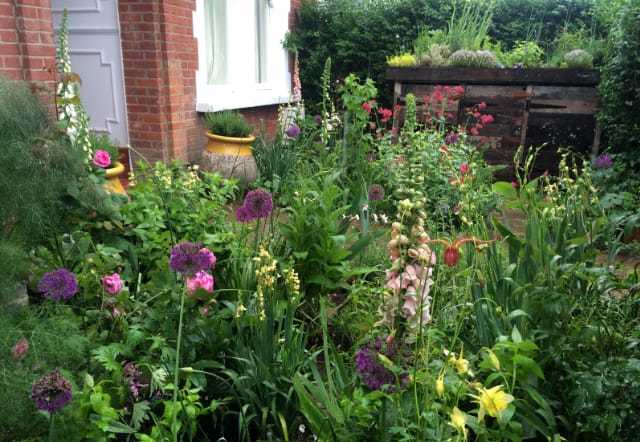Nestled in the heart of Queens Park, this front garden is a vibrant celebration of colour, scent and thoughtful design — a true cottage garden brought to life in a city setting.
Vision & Concept
The clients wanted a garden that felt lush, welcoming and full of life — even within a limited urban frontage. The design embraces the spirit of cottage gardens: layers of florals, soft forms, pollinator appeal, and a sense of spontaneity. The approach was to combine beauty and utility, weaving in features that serve practical needs without detracting from the garden’s charm.
A key structural feature is a bespoke shed made from reclaimed materials. Rather than presenting it as a mere storage unit, the shed becomes a garden focal point — its characterful texture and materials complement the planting. Above, a living roof of culinary herbs provides fragrance, visual interest, and cleverly conceals bin storage behind verdant cover.

Planting Palette & Atmosphere
The planting scheme is rich and layered, creating a tapestry of form, colour and fragrance. Key species highlighted in the design include:
- Foxgloves
- Alliums
- Centranthus
- Sissyrinchiums
These plants, chosen for their airy structure, long bloom periods, and ecological value, help the garden feel soft and relaxed yet rich in seasonal dynamics. They also attract pollinators and support biodiversity within an urban context.
Throughout the seasons, the garden shifts: bursts of pastel blooms, changes in foliage texture, and movement in grasses or smaller perennials. The result is a living, breathing space that responds to light, weather and the rhythms of nature.
Challenges & Solutions
1. Urban constraints & practical needs
Front gardens often have to accommodate bins, utility access, and limited depth. The shed with living roof cleverly addresses these points: it houses bins discreetly and provides structural form without feeling utilitarian.
2. Balancing richness and restraint
Too much exuberance in a small space can feel cluttered. The planting is curated to avoid overcrowding; there’s breathing room between forms, and strong points of structure (shed, paths, occasional evergreen anchors) ground the composition.
3. Longevity & maintenance
Perennials and self-seeding species were selected for resilience, so that while the garden evolves, it retains coherence. The reclaimed shed materials age naturally, and the living roof adds a low-maintenance green element that improves with time.

Outcome & Experience
Today, the garden reads as a romantic, yet grounded urban cottage front. The shed becomes part of the narrative, not a necessary afterthought. The planting softens edges, drifts toward the pavement, and invites closer inspection. The fragrance of herbs and flowers mingles with city sounds, creating a sensory buffer.
People passing by are drawn in by its richness; residents benefit from a daily encounter with nature, even from their doorstep. What was once a utilitarian frontage becomes a layered, living introduction to the home.
Key Lessons & Takeaways
- Structure with character — features like sheds or walls don’t have to be invisible; they can enhance the design if done with care and materials.
- Dual-function elements — the living roof and bin screening show how utility and beauty can coincide.
- Choose for seasons & ecology — pick plants with reliable performance, seasonal interest, and ecological value (pollinators, etc.).
- Curate exuberance — even in a cottage scheme, restraint in spacing and structural anchors keeps the design readable.

